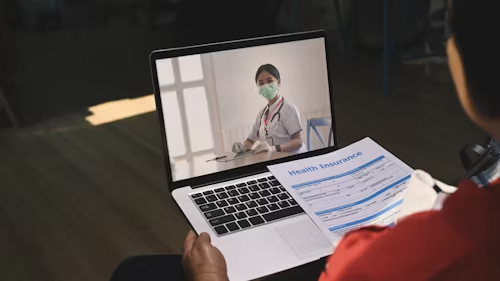Introduction
The rise of healthcare technology is revolutionizing the healthcare sector, especially in the domain of home-based care As the world continues to advance technologically, healthcare technology is undergoing a major transformation. From telemedicine to remote monitoring tools, these innovations are revolutionizing the way patients receive care, especially in the comfort of their own homes. These advancements not only improve convenience but also lead to better patient outcomes, reduced costs, and more accessible care. What does the future hold for at-home care? In this article, we explore how healthcare technology is elevating at-home care and the innovative solutions shaping the future of healthcare.

The Rise of Telemedicine: A Game Changer for Home-Based Healthcare
Telemedicine is a cornerstone of at-home care, allowing patients to consult with doctors remotely via video calls, phone consultations, or messaging platforms. This eliminates the need for travel and long waiting times, making healthcare more accessible. It’s especially beneficial for elderly individuals, those with chronic conditions, or those in rural areas where healthcare facilities may be scarce. Telemedicine makes it easier for healthcare providers to offer consultations, monitor ongoing treatment plans, and manage non-emergency cases remotely. With its growing integration into health systems, telemedicine is shaping the future of home-based care, expanding access to healthcare like never before.
For more information on telemedicine’s rise, visit this study: Telemedicine in Healthcare.
Remote Patient Monitoring: Continuous Care Without Leaving Home
One of the most exciting advancements in home healthcare is the rise of remote patient monitoring (RPM). RPM technologies use wearable devices or home-based health equipment to track vital signs like blood pressure, glucose levels, heart rate, and more. The data gathered is sent to healthcare providers who can analyze it in real-time and adjust the patient’s treatment plan.
RPM is especially useful for managing chronic diseases, as it enables continuous monitoring without the need for frequent hospital visits. By detecting early signs of complications, RPM helps patients stay healthier at home and avoid emergencies.
Artificial Intelligence (AI) in Home Healthcare: A Step Toward Smarter Care
AI is revolutionizing healthcare by analyzing large amounts of patient data to provide more personalized care. AI-powered tools can detect patterns, predict health risks, and suggest lifestyle changes, leading to proactive health management. In at-home care, AI also helps patients by providing virtual assistants for health reminders and managing medical conditions. These tools will continue to evolve, making healthcare smarter and more personalized.

To learn more about AI’s role in healthcare, check out this article: Pacific Dental Technology: Innovating the Future of Dental Care
The Benefits and Challenges of At-Home Healthcare Technology
Benefits
Convenience: Patients can receive medical advice, prescriptions, and follow-up care without leaving home.
Cost Savings: At-home healthcare technology reduces the need for hospital visits, helping patients save money.
Improved Health Outcomes: Continuous monitoring leads to more proactive care and fewer emergencies.
Challenges
- Digital Literacy: Some patients, especially the elderly, may struggle with using digital platforms or devices.
- Cost of Devices: Advanced technologies may have high upfront costs, making them inaccessible for some.
- Privacy Concerns: Storing and sharing patient data raises concerns about data security.
The Role of Wearable Devices in At-Home Healthcare
Wearable devices like smartwatches and fitness trackers are becoming more common in home healthcare. These devices monitor vital signs such as heart rate, oxygen levels, and sleep patterns. Some advanced wearables even track blood pressure and glucose levels, assisting patients with chronic conditions. These devices not only help patients track their health but also enable them to share data with healthcare providers, who can adjust treatment plans accordingly. Wearable technology empowers patients, contributing to better long-term health outcomes.
The Future of At-Home Healthcare: What’s Next?
As healthcare technology continues to evolve, the future of at-home care looks more promising than ever. Emerging trends include:
- AI-powered home healthcare apps for real-time health management.
- Smart home devices integrated with healthcare tools that remind patients to take medication, schedule appointments, and track health metrics.
- Advanced telemedicine platforms combining video consultations, patient records, and treatment plans.
With these innovations, at-home healthcare will become more efficient, cost-effective, and patient-centered.
FAQs
What is telemedicine, and how does it benefit at-home care?
Telemedicine allows remote consultations with healthcare professionals, eliminating the need for in-person visits and improving access to healthcare.
How does remote patient monitoring work?
RPM uses devices to track vital health metrics, with the data sent to healthcare providers for real-time analysis and adjustments to care plans.
What are the challenges of using healthcare technology at home?
Challenges include digital literacy, high device costs, and privacy concerns about sharing patient data online.
How is AI being used in home healthcare?
AI is used to analyze patient data, predict health risks, and provide personalized care. In home healthcare, AI tools can detect early signs of health issues, suggest lifestyle changes, and help doctors make informed decisions based on patient data.
Conclusion
The integration of healthcare technologies into at-home care is transforming the way we approach healthcare. From telemedicine to remote monitoring and AI-powered tools, patients now have access to more personalized, efficient, and cost-effective care. Despite challenges like digital literacy and privacy concerns, the future of at-home healthcare is bright, and these technologies are making healthcare more accessible and affordable for all.
For more information Correct Order of Steps for Handwashing: A Step-by-Step Guide



